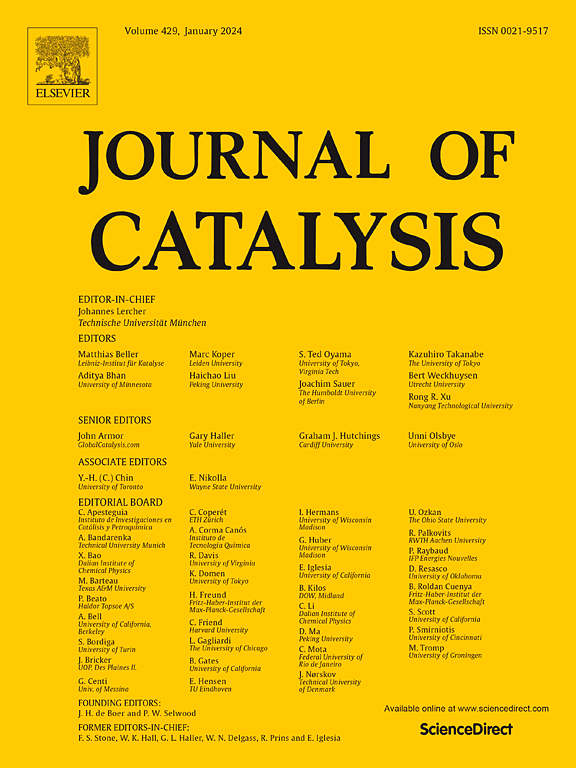Highly unsaturated oxygen promotes formaldehyde catalytic oxidation on the defective Co3O4 (111) surface: A DFT study
IF 6.5
1区 化学
Q2 CHEMISTRY, PHYSICAL
引用次数: 0
Abstract
The active oxygen, which was generated through surface oxygen vacancy, showed high activities in HCHO catalytic oxidation by Co3O4 but why the active oxygen was so highly active remained unclear. In this study, density functional theory calculations were performed to unravel the role of active oxygen in HCHO catalytic oxidation on the Co3O4 (1 1 1) surface. The reaction paths of HCHO catalytic oxidation on perfect and defective Co3O4 (1 1 1) surfaces via three possible reaction mechanisms (MvK, E–R and L–H) were investigated. The results showed that, on the perfect Co3O4 (1 1 1) surface, the HCHO catalytic oxidation only followed the MvK mechanism. On the defective surface, the E–R and L–H mechanisms showed advantage over MvK mechanism because of the low energy barriers of C![]() H bond cleavage. Moreover, owing to the active O, the L–H mechanism showed great advantage because of the extremely low energy barrier of 0.1 eV for the first C
H bond cleavage. Moreover, owing to the active O, the L–H mechanism showed great advantage because of the extremely low energy barrier of 0.1 eV for the first C![]() H bond cleavage. Further electronic structure calculations revealed that the high activity of active oxygen was mainly attributed to its high unsaturation degree, which induced a strong attraction of active oxygen to the H of HCHO and promoted C
H bond cleavage. Further electronic structure calculations revealed that the high activity of active oxygen was mainly attributed to its high unsaturation degree, which induced a strong attraction of active oxygen to the H of HCHO and promoted C![]() H bond cleavage.
H bond cleavage.


高度不饱和氧促进甲醛在缺陷Co3O4(111)表面的催化氧化:DFT研究
Co3O4在HCHO催化氧化过程中,通过表面氧空位生成的活性氧表现出较高的活性,但活性氧活性如此之高的原因尚不清楚。本研究通过密度泛函理论计算揭示了活性氧在Co3O4(11 11)表面HCHO催化氧化中的作用。研究了三种可能的反应机制(MvK、E-R和L-H)下HCHO在完美和缺陷Co3O4(11 11)表面上催化氧化的反应路径。结果表明,在完美的Co3O4(11 11)表面上,HCHO催化氧化仅遵循MvK机制。在缺陷表面,E-R和L-H机制比MvK机制更有优势,因为CH键的切割能垒较低。此外,由于O的活性,L-H机制表现出很大的优势,因为0.1 eV的极低能垒对第一个CH键的切割。进一步的电子结构计算表明,活性氧的高活性主要是由于它的高不饱和度,这使得活性氧对HCHO中的H具有很强的吸引力,促进了CH键的裂解。
本文章由计算机程序翻译,如有差异,请以英文原文为准。
求助全文
约1分钟内获得全文
求助全文
来源期刊

Journal of Catalysis
工程技术-工程:化工
CiteScore
12.30
自引率
5.50%
发文量
447
审稿时长
31 days
期刊介绍:
The Journal of Catalysis publishes scholarly articles on both heterogeneous and homogeneous catalysis, covering a wide range of chemical transformations. These include various types of catalysis, such as those mediated by photons, plasmons, and electrons. The focus of the studies is to understand the relationship between catalytic function and the underlying chemical properties of surfaces and metal complexes.
The articles in the journal offer innovative concepts and explore the synthesis and kinetics of inorganic solids and homogeneous complexes. Furthermore, they discuss spectroscopic techniques for characterizing catalysts, investigate the interaction of probes and reacting species with catalysts, and employ theoretical methods.
The research presented in the journal should have direct relevance to the field of catalytic processes, addressing either fundamental aspects or applications of catalysis.
 求助内容:
求助内容: 应助结果提醒方式:
应助结果提醒方式:


